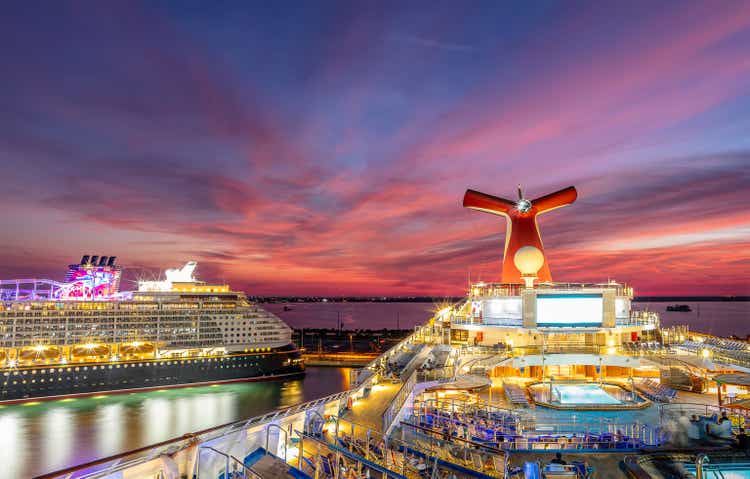
SeregaSibTravel/iStock Editorial via Getty Images
Shares of Carnival Corporation (NYSE:CCL) are trending higher Tuesday after the company’s FQ2 results beat Wall Street’s expectations and indicated robust demand for cruises, as evidenced by a new record high in deposits. In addition, forecasts for FQ3 and FY24 indicate 20% improvement in adjusted EBITDA and +$275M revision to adjusted net income for the full year.
“We have made incredible strides in improving our commercial operations, strategically reallocating our portfolio composition and formulating growth plans, while strengthening even further our global team,” Carnival CEO Josh Weinstein said, adding that, “off the back of that effort, we closed yet another quarter delivering records, this time across revenues, operating income, customer deposits and booking levels, exceeding our guidance on every measure.”
The company is now projecting double-digit returns on invested capital, net yields now forecasted to top ten percent, and nearly two-thirds of the way to achieving the company’s three 2026 SEA Change targets two years ahead of schedule.
The results are keeping shares within the sector afloat as well with competitors Norwegian Cruise Lines (NCLH), Royal Caribbean (RCL) and Viking Holdings (VIK) all trading higher.
While the results are encouraging, it’s not all smooth sailing for Carnival going forward. The company is still carrying a large debt load, and its expensive valuation could keep investors on the sidelines.
The results were better than anticipated, Morgan Stanley acknowledges, and the improvement in net cruise costs (4.5% from 5.0%, prior) was unexpected. But despite the impressive results, the firm maintained its Underweight rating on the stock, largely due to weak pricing/yields versus its peers, high leverage and high valuation as the shares trade at 16x FY24e P/E versus a 3-yr pre-COVID average of 13.2x.
The same holds true for SA investors Manika Premsingh and Juxtaposed Ideas, both of whom maintain a cautious outlook for the company despite robust booking trends and upbeat guidance. Both cite the company’s high leverage (long-term debt is $27.2B compared to $19B for Royal Caribbean) and high market multiples. Juxtaposed Ideas calls the company’s balance sheet a “headwind to its recovery” with $1.7B in debts maturing in 2024, $2.4B in 2025, and $3.3B in 2026, and 19% of its debt exposed to variable rates.
“We believe that its hefty debts and consequently higher for longer interest rate expenses may trigger further headwind to its eventual bottom-line recovery,” Juxtaposed Ideas says, with Morgan Stanley adding that Carnival’s (CCL) high leverage, combined with high ongoing capex requirements could require further equity raises which become even more problematic with an expensive valuation.
